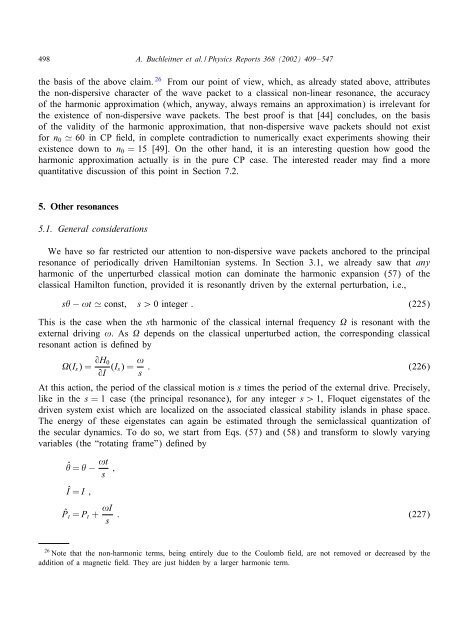Non-dispersive wave packets in periodically driven quantum systems
Non-dispersive wave packets in periodically driven quantum systems
Non-dispersive wave packets in periodically driven quantum systems
You also want an ePaper? Increase the reach of your titles
YUMPU automatically turns print PDFs into web optimized ePapers that Google loves.
498 A. Buchleitner et al. / Physics Reports 368 (2002) 409–547<br />
the basis of the above claim. 26 From our po<strong>in</strong>t of view, which, as already stated above, attributes<br />
the non-<strong>dispersive</strong> character of the <strong>wave</strong> packet to a classical non-l<strong>in</strong>ear resonance, the accuracy<br />
of the harmonic approximation (which, anyway, always rema<strong>in</strong>s an approximation) is irrelevant for<br />
the existence of non-<strong>dispersive</strong> <strong>wave</strong> <strong>packets</strong>. The best proof is that [44] concludes, on the basis<br />
of the validity of the harmonic approximation, that non-<strong>dispersive</strong> <strong>wave</strong> <strong>packets</strong> should not exist<br />
for n0 60 <strong>in</strong> CP eld, <strong>in</strong> complete contradiction to numerically exact experiments show<strong>in</strong>g their<br />
existence down to n0 = 15 [49]. On the other hand, it is an <strong>in</strong>terest<strong>in</strong>g question how good the<br />
harmonic approximation actually is <strong>in</strong> the pure CP case. The <strong>in</strong>terested reader may nd a more<br />
quantitative discussion of this po<strong>in</strong>t <strong>in</strong> Section 7.2.<br />
5. Other resonances<br />
5.1. General considerations<br />
We have so far restricted our attention to non-<strong>dispersive</strong> <strong>wave</strong> <strong>packets</strong> anchored to the pr<strong>in</strong>cipal<br />
resonance of <strong>periodically</strong> <strong>driven</strong> Hamiltonian <strong>systems</strong>. In Section 3.1, we already saw that any<br />
harmonic of the unperturbed classical motion can dom<strong>in</strong>ate the harmonic expansion (57) of the<br />
classical Hamilton function, provided it is resonantly <strong>driven</strong> by the external perturbation, i.e.,<br />
s − !t const; s¿0 <strong>in</strong>teger : (225)<br />
This is the case when the sth harmonic of the classical <strong>in</strong>ternal frequency is resonant with the<br />
external driv<strong>in</strong>g !. As depends on the classical unperturbed action, the correspond<strong>in</strong>g classical<br />
resonant action is de ned by<br />
(Is)= 9H0 !<br />
(Is)= : (226)<br />
9I s<br />
At this action, the period of the classical motion is s times the period of the external drive. Precisely,<br />
like <strong>in</strong> the s = 1 case (the pr<strong>in</strong>cipal resonance), for any <strong>in</strong>teger s¿1; Floquet eigenstates of the<br />
<strong>driven</strong> system exist which are localized on the associated classical stability islands <strong>in</strong> phase space.<br />
The energy of these eigenstates can aga<strong>in</strong> be estimated through the semiclassical quantization of<br />
the secular dynamics. To do so, we start from Eqs. (57) and (58) and transform to slowly vary<strong>in</strong>g<br />
variables (the “rotat<strong>in</strong>g frame”) de ned by<br />
ˆ = − !t<br />
s ;<br />
Î = I;<br />
ˆPt = Pt + !I<br />
s<br />
: (227)<br />
26 Note that the non-harmonic terms, be<strong>in</strong>g entirely due to the Coulomb eld, are not removed or decreased by the<br />
addition of a magnetic eld. They are just hidden by a larger harmonic term.











